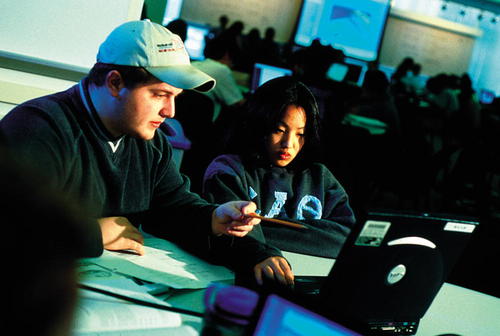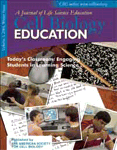Points of View: Lectures: Can't Learn with Them, Can't Learn without Them
How to decide on the format for an undergraduate course in cell biology—a “standard” combination of lectures and recitations sections, or something else? The answer depends on many factors, including the numbers, abilities, and course backgrounds of the students and, perhaps most importantly, the purpose of the course. Thus, to explain why we feel that our junior-senior level cell biology course, taught with a combination of lectures, teaching assistant (TA)-led recitation sections, and extensive problem sets, works extraordinarily well for the vast majority of Massachusetts Institute of Technology (MIT) students and accomplishes its intended purposes, we need to describe several aspects of the MIT undergraduate curriculum and also what we expect the students to learn in the course.
An introductory course in biology, also taught in the lecture/recitation section/problem set mode, is required of all MIT students and is usually taken in the freshman year. Students interested in biology or bioengineering will also take organic chemistry in the freshman year, and both biochemistry and genetics (also in the lecture/recitation/problem set format) in the second year. Generally in the sophomore year, these students will also take the introductory laboratory course in biology, which teaches basic techniques in genetics (e.g., mutant hunts and mapping), biochemistry (e.g., enzyme assays), cell biology and microscopy, and some developmental biology.
Our course has prerequisites of both biochemistry and genetics, and most of the students have taken the introductory laboratory course. Thus we are able to teach at a fairly high level. One of us (HL) has had over 25 years of experience teaching this course, generally sharing the responsibility with another instructor.
Our goals are several-fold. First, we want to teach the basic facts and concepts of broad areas of modern cell biology, ranging from membrane transport and vesicle trafficking to control of the cell cycle and the functions of cytoskeletal and extracellular matrix proteins. We want the students to understand the experimental underpinnings of these key concepts. Perhaps most importantly, we want to teach the students how to apply the experimental techniques they have been exposed to in previous courses to real research problems. We want them to be able to understand experiments that utilize a broad range of research techniques ranging from recombinant expression of proteins to cellular imaging to protein-protein interactions. We want our students to understand why yeasts are so useful for studies such as on the cell cycle and vesicle transport, and why many results obtained with this organism are immediately relevant to mammals. Our students also come to appreciate the importance of genetic studies in flies and worms in fundamental aspects of cell biology such as cell-cell signaling. Finally, we want our students to be able to integrate genetic, biochemical, and morphological approaches in designing experiments to test a particular hypothesis, and we want them to be able to interpret experimental results that use multiple methodologies and experimental organisms.
Indeed, these are ambitious goals but we feel that our lecture/recitation session/problem set format works very well for the; 180 students in this one-semester course each year. RKR vouches for this based on his experience as a TA in the course and previously as an undergraduate at the University of California, Davis, where he had several classes in this format.
The lectures are a key part of the course but clearly lectures alone are not enough. The lectures are tightly integrated with the other two parts of the course.
During much of each 90-minute lecture the instructor mainly tries to discuss the “big picture” and motivates the students to learn particular topics. One way to do this is to tell the students not only what is most important about a particular topic, but explain to them why it is important. Another way to motivate students to learn topics like cyclin-dependent kinases or sodium-coupled transport proteins is to relate studies on isolated proteins and cells in culture to important functions of cells in the organism and, more broadly, to human physiology. We present many examples, especially from human medicine, that have proven useful in exciting the student's interest. For instance, alterations in cyclin-dependent kinases (Cdks) in certain cancers inform the lectures on cell-cycle control, and the fact that certain psychiatric medicines are inhibitors of sodium-coupled transport proteins inform discussions of membrane transport.
The lectures also outline the principal types of experimental techniques for studying particular problems, (e.g., patch clamping for measuring ion flow through single-channel proteins or green fluorescent protein fusions to study protein trafficking in living cells). Special effort is paid to the integration of biochemical and genetic studies, (e.g., in the analysis of the cell cycle and apoptosis). However, the details of these techniques are generally reserved for the problem sets and the recitation sections.
There are many ways we keep a large class of students in an auditorium engaged and attentive during our 90-min lectures. For example, the Microsoft PowerPoint slides used in the lecture are on the web before the class. Many students download then beforehand, enabling them to write notes on the printouts during the lectures.
Photo by Stuart Darsch.
Even in a relatively large lecture one can have discussions that involve several students as well as the instructor and, occasionally, a TA. One way to do this is for the instructor to pause several times during the lecture and repeatedly encourage students to ask questions. Another way to elicit questions is to reiterate the point that, if any student feels confused about a point, many others in the class undoubtedly are also confused but are too reluctant to speak up. Another method is to “bait” the class telling them that, because they ask fewer questions than last year's group, they must be less talented.
During these pauses the lecturer roams through the lecture theater with a portable microphone and insists that the student volunteers use it to ask questions so that everyone can hear the discussion. Often these questions lead into tangential but interesting side discussions. Occasionally the lecturer will call on several students to improve on the original answer or to suggest alternatives (e.g., Do you think that Sara gave the correct answer? Can anyone tell me why it might be wrong? Before I tell you the correct answer shall we vote on whether John or Sara is correct?).
It is important for students to hear from the lecturer that not all questions have answers. There is much in cell biology that is not known; often the most illuminating part of a lecture is when the students learn why a particular question is so difficult to answer experimentally. Spontaneity and knowledge of the current literature on the part of the lecturer is helpful; sometimes in response to a student question one can bring up results obtained with a different experimental system and use the opportunity to explain, as an example, why a genetic rather than a subcellular fractionation experiment led to the answer.
Another way to encourage participation, even among the students in a large class, is for the lecturer to ask the class how one might design an experiment to test a particular hypothesis. Again, student volunteers use the portable microphone to speak, and the lecturer gives hints and asks others to suggest improvement until several students have spoken and the class has come to agree on a particular strategy. These class discussions generally last five to 10 minutes; they do help increase the students' interest in the material and also help them think about experimental design and interpretation.
Photo by Stuart Darsch.
The problem sets—eight sets per semester each with one-half dozen difficult and generally multipart questions—are an essential part of the course. These questions are newly generated each year by the TAs and ask the student to solve a numerical problem (e.g., use the Nernst equation to calculate membrane potential changes), interpret a set of experimental data, or design a set of experiments to test a certain hypothesis. These are not graded and are meant to illustrate the types of questions on the four open-book exams. All problem sets and exams from the past five years of the course are posted on the class web site, generally in versions with and without the answer key. In this way students have ample problems with which to practice their mastery of the topic.
One disadvantage of this format is that the lecturer gets to know relatively few of the students in the course. Given the large number of the students and the need to preserve the sanity of both the lecturers and the TAs, this is a necessary trade-off. However, this is one reason why we have recitation sections, as they allow smaller groups of students (about 30 students per section) to get more personal attention from a TA.
The recitation sections are meant to be a forum for students to learn how to apply the techniques they learn in lecture and to go over the problem sets. Whereas the lectures expand on the history and theories of cell biology, the sections focus on developing the skills that students need to apply their knowledge to experimental approaches to cell biology. The TAs are second- and fourth-year students in our Ph.D. program. They meet regularly as a group and work together with the course lecturer to plan the recitation sessions and the problem sets.
During the hour-long sessions, the TAs go over many common cell biology techniques and experimental designs, which help to teach the students how to solve multiple types of problems in cell biology. They also lead students through practice problems similar to the assigned homework problems, and often present short lectures that emphasize how techniques are used to experimentally approach specific types of problems.
Through problem sets and practice problems covered in sections students progress in their ability to solve problems and design experiments as the semester goes along. The TAs expect the students to use these sections to practice their developing skills and to ask questions in order to clarify any questions they may have about the material. If the students come prepared, they should be able to think, analyze, and solve the problems that the TAs pose to them every week.
One difficulty with the recitation sections is that the students are usually not as prepared as we would like. Ideally, after each lecture the students will have read the accompanying chapter in their text book and started to work on some of the problems in the assigned problem sets. Then, the students would come prepared to section ready to ask questions to help assuage any deficiencies they may have in their learning. Ideally, we would like the students to ask specific questions about what is confusing them and how they can use the techniques they've learned in class to solve the assigned problems. Instead, many students put off reading the textbook and practicing their problem-solving skills and expect the TAs to cover everything they need to know to do well on the exams during the recitation section. The students expect the TAs to cover the important lecture material, highlight the techniques they will need to know, and show them how to apply it to solve problems all within the single hour per week that the TAs meet with them! Obviously, this is an unattainable goal!
Nonetheless, most of the students do well on the exams, which require a fairly high level of understanding of broad areas of cell biology. The exam questions usually ask the student for interpretations of experiments or ask the student to design a genetic or biochemical experiment to test a specific hypothesis. Many students struggle at the beginning of the course because they never had to deal with problems in experimental design and interpretation in earlier courses. However, we find that at the end, a large majority of the students will have mastered the broad concepts of cell biology and also understand how research in this field is carried out and why this research is important. The lectures, the problem sets, and the recitation sections all are important parts of the course.



